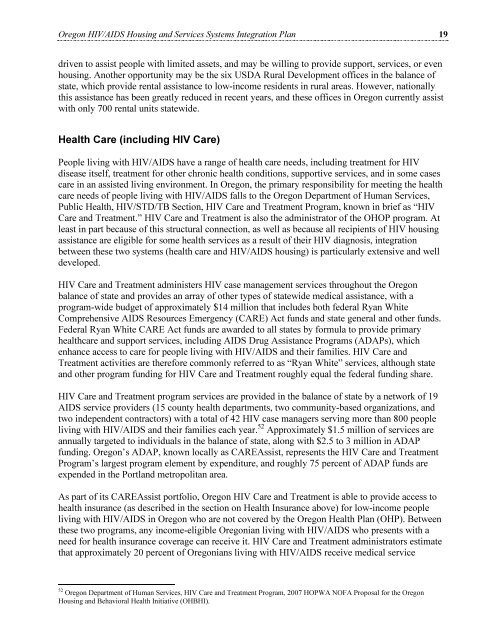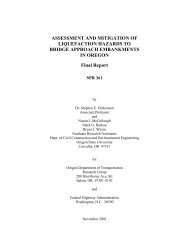Oregon Balance of State HIV/AIDS Housing & Services Systems ...
Oregon Balance of State HIV/AIDS Housing & Services Systems ...
Oregon Balance of State HIV/AIDS Housing & Services Systems ...
You also want an ePaper? Increase the reach of your titles
YUMPU automatically turns print PDFs into web optimized ePapers that Google loves.
<strong>Oregon</strong> <strong>HIV</strong>/<strong>AIDS</strong> <strong>Housing</strong> and <strong>Services</strong> <strong>Systems</strong> Integration Plan 19<br />
driven to assist people with limited assets, and may be willing to provide support, services, or even<br />
housing. Another opportunity may be the six USDA Rural Development <strong>of</strong>fices in the balance <strong>of</strong><br />
state, which provide rental assistance to low-income residents in rural areas. However, nationally<br />
this assistance has been greatly reduced in recent years, and these <strong>of</strong>fices in <strong>Oregon</strong> currently assist<br />
with only 700 rental units statewide.<br />
Health Care (including <strong>HIV</strong> Care)<br />
People living with <strong>HIV</strong>/<strong>AIDS</strong> have a range <strong>of</strong> health care needs, including treatment for <strong>HIV</strong><br />
disease itself, treatment for other chronic health conditions, supportive services, and in some cases<br />
care in an assisted living environment. In <strong>Oregon</strong>, the primary responsibility for meeting the health<br />
care needs <strong>of</strong> people living with <strong>HIV</strong>/<strong>AIDS</strong> falls to the <strong>Oregon</strong> Department <strong>of</strong> Human <strong>Services</strong>,<br />
Public Health, <strong>HIV</strong>/STD/TB Section, <strong>HIV</strong> Care and Treatment Program, known in brief as “<strong>HIV</strong><br />
Care and Treatment.” <strong>HIV</strong> Care and Treatment is also the administrator <strong>of</strong> the OHOP program. At<br />
least in part because <strong>of</strong> this structural connection, as well as because all recipients <strong>of</strong> <strong>HIV</strong> housing<br />
assistance are eligible for some health services as a result <strong>of</strong> their <strong>HIV</strong> diagnosis, integration<br />
between these two systems (health care and <strong>HIV</strong>/<strong>AIDS</strong> housing) is particularly extensive and well<br />
developed.<br />
<strong>HIV</strong> Care and Treatment administers <strong>HIV</strong> case management services throughout the <strong>Oregon</strong><br />
balance <strong>of</strong> state and provides an array <strong>of</strong> other types <strong>of</strong> statewide medical assistance, with a<br />
program-wide budget <strong>of</strong> approximately $14 million that includes both federal Ryan White<br />
Comprehensive <strong>AIDS</strong> Resources Emergency (CARE) Act funds and state general and other funds.<br />
Federal Ryan White CARE Act funds are awarded to all states by formula to provide primary<br />
healthcare and support services, including <strong>AIDS</strong> Drug Assistance Programs (ADAPs), which<br />
enhance access to care for people living with <strong>HIV</strong>/<strong>AIDS</strong> and their families. <strong>HIV</strong> Care and<br />
Treatment activities are therefore commonly referred to as “Ryan White” services, although state<br />
and other program funding for <strong>HIV</strong> Care and Treatment roughly equal the federal funding share.<br />
<strong>HIV</strong> Care and Treatment program services are provided in the balance <strong>of</strong> state by a network <strong>of</strong> 19<br />
<strong>AIDS</strong> service providers (15 county health departments, two community-based organizations, and<br />
two independent contractors) with a total <strong>of</strong> 42 <strong>HIV</strong> case managers serving more than 800 people<br />
living with <strong>HIV</strong>/<strong>AIDS</strong> and their families each year. 52 Approximately $1.5 million <strong>of</strong> services are<br />
annually targeted to individuals in the balance <strong>of</strong> state, along with $2.5 to 3 million in ADAP<br />
funding. <strong>Oregon</strong>’s ADAP, known locally as CAREAssist, represents the <strong>HIV</strong> Care and Treatment<br />
Program’s largest program element by expenditure, and roughly 75 percent <strong>of</strong> ADAP funds are<br />
expended in the Portland metropolitan area.<br />
As part <strong>of</strong> its CAREAssist portfolio, <strong>Oregon</strong> <strong>HIV</strong> Care and Treatment is able to provide access to<br />
health insurance (as described in the section on Health Insurance above) for low-income people<br />
living with <strong>HIV</strong>/<strong>AIDS</strong> in <strong>Oregon</strong> who are not covered by the <strong>Oregon</strong> Health Plan (OHP). Between<br />
these two programs, any income-eligible <strong>Oregon</strong>ian living with <strong>HIV</strong>/<strong>AIDS</strong> who presents with a<br />
need for health insurance coverage can receive it. <strong>HIV</strong> Care and Treatment administrators estimate<br />
that approximately 20 percent <strong>of</strong> <strong>Oregon</strong>ians living with <strong>HIV</strong>/<strong>AIDS</strong> receive medical service<br />
52 <strong>Oregon</strong> Department <strong>of</strong> Human <strong>Services</strong>, <strong>HIV</strong> Care and Treatment Program, 2007 HOPWA NOFA Proposal for the <strong>Oregon</strong><br />
<strong>Housing</strong> and Behavioral Health Initiative (OHBHI).

















